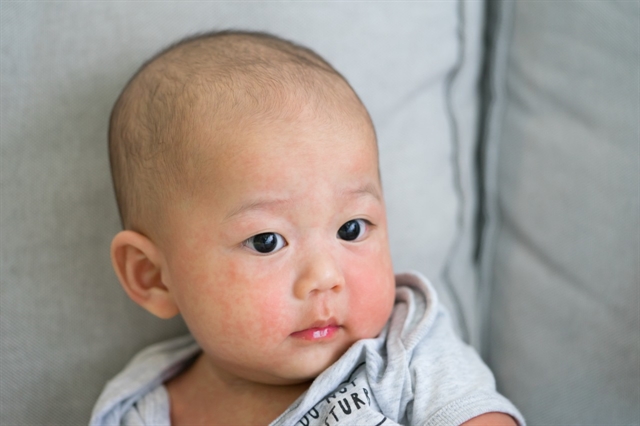 Life & Style
Life & Style


|
| Dr Mattias Larsson. Photo courtesy of Family Medical Practic |
Dr Mattias Larsson*
Ngãi, four years old and a usually vigorous boy, fell ill with a fever up to 39.8°C, sore throat, runny nose and bilaterally red eyes. His mother Hiền gave him paracetamol which gave some temporary improvement, but the fever returned fast. Ngãi developed fatigue and an increasing rash and eruptions on the lips. After three days of fever, his mother Hiền decided to take him to the local doctor who diagnosed throat infection and gave amoxicillin antibiotic treatment. However, after three more days, Ngãi still has a high fever. He also developed a rash on the hands and feet, peeling skin on the fingers and toes, increased rash and swelling of the lips, mouth, tongue and throat as well as diarrhea and had no appetite.
Hiền then decides to take Ngãi to the Family Medical Practice. The paediatrician examined and found a rash on the roof and back of the mouth and swollen red lips. On the left side of his neck, he had several lymph nodes, tender and freely displaceable. Both eardrums appeared slightly red, but there were no signs of bulging. The heart has a regular rhythm and frequency. Blood tests showed slight anemia, increased white blood cell count and high CRP in the blood, indicating an inflammation.
The paediatrician explained that Ngãi met the criteria for Kawasaki disease with fever for more than four days, strawberry tongue, rash on the lips, swollen lymph nodes and rash. Hiền had a Kawasaki motorbike and asked if it was related to the fact that she often drove him on the bike. The paediatrician said most likely not, although the cause of this disease is not fully known, and further explained that Kawasaki disease is a rare heart condition that develops suddenly and causes a high fever and inflammation of the blood vessels. It usually affects children under the age of five years. Infections may cause the immune system to develop antibodies that attack blood vessels, such as the coronary arteries which carry blood to the heart muscle, which become inflamed and swollen. Boys are slightly more likely than girls to develop Kawasaki disease. Kawasaki disease is more common in people of Asian descent. It is not contagious, so it cannot spread from person to person.
The doctor also explained that echocardiography should be done as Kawasaki disease is associated with coronary artery dilatation and development of aneurysm (an abnormal bulge in blood vessels that can burst). Other potential complications may include abnormal heart rhythm, blood clots which can lead to heart attacks, inflammation of the coronary arteries, heart valve problems and inflammation of heart muscle.
The doctor also said that treatment with intravenous immunoglobulins (IVIG) should be started as soon as possible to reduce the risk of coronary artery disease. IVIG is a product derived from plasma (the liquid portion of blood) that contains antibodies that help prevent heart damage. No examinations are needed before starting treatment. High-dose acetylsalicylic acid (ASA) therapy controls fever and prevents blood clots.
The echocardiography showed normal heart size and coronary vessels. Chest X-ray and EKG was also normal.
Soon after receiving IVIG and starting treatment with ASA Ngai improves, the fever and rash almost completely disappears. His mother asked if there are any risks with the motorcycle disease (Kawasaki disease) and what if any follow up is needed.
The doctor explained that Ngãi will continue with ASA treatment. Follow-up with ultrasound after two and then eight weeks, if these are normal the treatment is terminated and no follow-up is needed. If the ultrasound shows coronary artery involvement or an aneurysm, follow-up and treatment must continue with extended ASA course and new ECG and ultrasound at 6-12 month intervals. If there are large aneurysms >8 mm or stenoses continued ASA must be given and regular checks of EKG/UKG up.

|
| Kawasaki disease usually affects children under the age of five years. — Photo shutterstock.com |
The doctor explained that prompt treatment of Kawasaki disease can greatly reduce the risk of heart damage and other complications, as it seemed Ngãi had not developed any complications. Hiền thought it was luck that she had gone to FMP before Ngãi developed a more severe disease. Family Medical Practice
*Dr Mattias Larsson is a paediatric doctor at Family Medical Practice and associate professor at Karolinska Institutet and has a long experience in research on infectious diseases. He has worked with the Oxford University Clinical Research Unit and the Ministry of Health of Vietnam. He is fluent in English, Swedish, Vietnamese, German and some Spanish.
Visit Family Medical Practice Hanoi 24/7 at 298I P. Kim Mã, Kim Mã Ward, Ba Đình Dist.
To book an appointment, please call us at (024).3843.0784 or via Whatsapp, Viber or Zalo on +84.944.43.1919 or email hanoi@vietnammedicalpractice.com.
FMP’s downtown location in Hồ Chí Minh City is in Diamond Plaza, 34 Lê Duẩn St, Bến Nghé Ward, District 1, and 95 Thảo Điền St, District 2. Tel. (028) 3822 7848 or email hcmc@vietnammedicalpractice.com.




